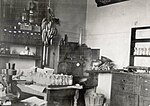Bloomingdale Insane Asylum

The Bloomingdale Insane Asylum (1821–1889) was an American private hospital for the care of the mentally ill, founded by New York Hospital. It was located in the Morningside Heights neighborhood of Manhattan in New York City, where Columbia University is now located. It relocated to White Plains, New York, as the Payne Whitney Psychiatric Clinic, now known as the "NewYork-Presbyterian Westchester Behavioral Health Center."The road leading to the asylum from the thriving city of New York (at the time consisting only of lower Manhattan) was called Bloomingdale Road in the 19th century, and is now called Broadway. The term "Bloomingdale" dates back to the era of Dutch rule in New Amsterdam, and is possibly a reference to "Bloemendael," the name of a small village in the flower-growing region near Haarlem in the Netherlands. Bloomingdale is described as being a small village on the island, in Spafford's Gazetteer, of 1813.
Excerpt from the Wikipedia article Bloomingdale Insane Asylum (License: CC BY-SA 3.0, Authors, Images).Bloomingdale Insane Asylum
Low Library Steps, New York Manhattan
Geographical coordinates (GPS) Address Website Nearby Places Show on map
Geographical coordinates (GPS)
| Latitude | Longitude |
|---|---|
| N 40.808611111111 ° | E -73.961388888889 ° |
Address
Columbia University (Columbia University in the City of New York)
Low Library Steps
10027 New York, Manhattan
New York, United States
Open on Google Maps








